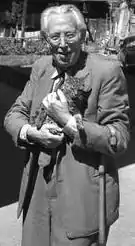Kurt Reidemeister
Kurt Werner Friedrich Reidemeister (13 October 1893 – 8 July 1971) was a mathematician born in Braunschweig (Brunswick), Germany.
Kurt Werner Friedrich Reidemeister | |
|---|---|
 1956(1958?) in Switzerland | |
| Born | 13 October 1893 |
| Died | 8 July 1971 (aged 77) |
| Nationality | Germany |
| Alma mater | University of Hamburg |
| Spouse(s) | Elisabeth Wagner (Riga) |
| Scientific career | |
| Fields | Mathematics |
| Thesis | Über die Relativklassenzahl gewisser relativ-quadratischer Zahlkörper (1921) |
| Doctoral advisor | Erich Hecke |
| Doctoral students | Günter Hotz, Heiner Zieschang |
Life
He was a brother of Marie Neurath. Beginning in 1912, he studied in Freiburg, Munich, Marburg, and Göttingen. In 1920, he got the staatsexamen (master's degree) in mathematics, philosophy, physics, chemistry, and geology. He received his doctorate in 1921 with a thesis in algebraic number theory at the University of Hamburg under the supervision of Erich Hecke.[1][2][3]
He became interested in differential geometry; he edited Wilhelm Blaschke's 2nd volume about that issue,[4] and both made an acclaimed contribution to the Jena DMV conference in Sep 1921.[5][6]
In October 1922[2][3] (or 1923)[1] he was appointed assistant professor at the University of Vienna. While there he became familiar with the work of Wilhelm Wirtinger on knot theory, and became closely connected to Hans Hahn and the Vienna Circle. Its manifesto (1929) lists one of Reidemeister's publications[7] in a bibliography of closely related authors.
In 1925 he became full professor at University of Königsberg; he stayed until 1933, when he was regarded politically unsound by the Nazis, and dismissed from his chair.
Blaschke managed to get a promise about Reidemeister's reappointment, and in autumn 1934 he got the chair of Kurt Hensel in Marburg. He stayed there, except for a visit to the Princeton Institute for Advanced Study in 1948–1950, until he got appointed to Göttingen University in 1955, where he stayed until his emeritation.[1][2][3]
Works
Reidemeister's interests were mainly in combinatorial group theory, combinatorial topology, geometric group theory, and the foundations of geometry. His books include Knoten und Gruppen (1926), Einführung in die kombinatorische Topologie (1932), and Knotentheorie (1932).(Knoten und Gruppen (1926) is a seminal paper by Reidemeister on knot theory. It is not a book.) He co-edited the journal Mathematische Annalen from 1947 until 1963.[8]
References
- O'Connor, John J.; Robertson, Edmund F., "Kurt Reidemeister", MacTutor History of Mathematics archive, University of St Andrews.
- Rafael Artzy (1972). "Kurt Reidemeister 13.10.1893 — 8.7.1971". Jber. DMV (in German). 74: 96–104.
- Friedrich Bachmann and Heinrich Behnke and Wolfgang Franz (1972). "In memorian Kurt Reidemeister" (PDF). Math. Ann. (in German). 199 (1): 1–11. doi:10.1007/bf01419571. S2CID 122203410.
- Wilhelm Blaschke, Vorlesungen über Differentialgeometrie, Springer, Grundlehren der mathematischen Wissenschaften, 1921-1929, vol. 2: Affine Differentialgeometrie
- Jahresversammlung in Jena vom 18.—25. September 1921, Jahresbericht der Deutschen Mathematiker-Vereinigung, vol.30, p.27-28, 1921
- W. Blaschke and K. Reidemeister (1922). "Über die Entwicklung der Affingeometrie" (PDF). Jahresbericht DMV. 31: 63–81.
- Kurt Reidemeister (1928). "Exaktes Denken". Philosophischer Anzeiger. 3: 15–47.
- Title page of vol.274 (1986)
External links
| Wikimedia Commons has media related to Kurt Reidemeister. |